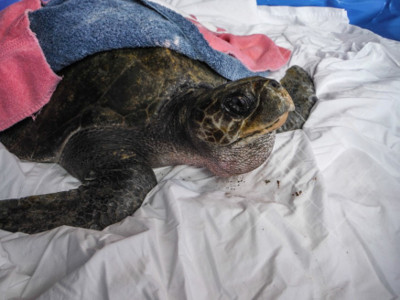Sea turtles forage for food in an offshore warm-water current that originates much farther South. Certain weather patterns like prolonged Southwest winds can drive that warm water farther North and closer to shore than usual. If this happens and then conditions suddenly change, the warm current dissipates, and the turtles find themselves trapped in the colder currents that run naturally along the Oregon and Washington Coasts. Turtles like all reptiles are cold blooded, so this is a highly unfavorable situation for them. Their bodily functions slow and they may become hypothermic. Strong west winds can blow hypothermic sea turtles onto the beach, where they have a better chance of being found and taken to a rehabilitation facility.
Turtles suffering from extreme hypothermia may be unresponsive to touch. Their heartbeat may be so slow and weak that it's difficult even to detect. There are two licensed rehab facilities on the Northwest Coast: the Oregon Coast Aquarium and the Seattle Aquarium. It can take multiple weeks for a turtle to stabilize from such trauma, if it recovers at all. If it does indeed stabilize, the turtle is transferred to another rehab facility in California where it may continue its recovery. If all goes well, it's finally released back into the wild!
So what do you do if you come across a sea turtle on the beach?
First, please either call the Seaside Aquarium at 503-738-6211, or call the local police. Report the location and condition of the turtle and the responder will give you further instructions.  The quicker a turtle gets reported, the quicker authorities are then able to get it off the beach, and the better it's chances are for survival -so thanks in advance for your help! The quicker a turtle gets reported, the quicker authorities are then able to get it off the beach, and the better it's chances are for survival -so thanks in advance for your help!
|

